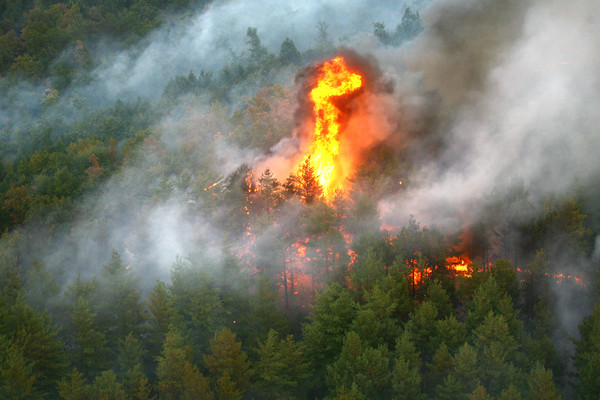
Fire prevention: maintenance experiences in Siena
The results of trials carried out by DREAm Italia in the regional forest of Merse have been published. These covered types of vehicles, costs and operating conditions tested to derive parameters for the effective construction of fireroads
In the prevention of forest fires, one of the most important and common measures is reducing the available fuel, namely plants. In general, the main actions seek to stop the horizontal and vertical continuity of the tree and shrub layer, so that the fire does not turn from “ground” fire to “canopy” fire. Thinning, trimming and pruning have the common goal of reducing a fire’s intensity, speed and area.
For this purpose, fireroads and/or firebreaks are often created to interrupt the continuity of the plant cover. These interruptions, in order to be functional, must of course be properly designed and periodically maintained, with potentially considerable costs.
Generally, firebreaks and fireroads, which differ from the former by providing internal forest roads, are created in state-owned forests, but may also involve private property in some geographical areas. These infrastructures are created with mechanical equipment (dozers, excavators and brushcutters carried on tractors) and can be maintained with mechanized and non-mechanized work systems.
As part of a project carried out by DREAm Italia regarding the use of controlled burns as a tool for managing and maintaining fireroads in the La Merse (SI) regional forest dominated by maritime pine (Pinus pinaster), it was possible to test the potential of the brushcutter carried on a tractor during the creation of safety strips and brushcutting of certain areas.
After completing the first phase of work, carried out with a Same Antares 110 Hp tractor with reversible drive 1992, Seppi Midiforst 225 mulcher with fixed carbide hammers, Hitachi 35 excavator, Husqvarna chainsaws (mod. 353, 346, 357) and Stihl MS200T, plus portable brushcutters Mitsubishi TL52, it was possible to assess the problems and potential of the tools used. It should be recognized that there are variables that can affect productivity and costs, such as: the type of soil and topsoil, the ruggedness of the terrain, accessibility, type of operation, type of vehicle and equipment, obsolescence of the vehicles and, not least, the training of the personnel.
The main problems that emerged from the trial can be summarized as follows. Broken carbide hammers (20) due to contact with outcropping rocks and stones. The operators had to drive the tractor very carefully to try and avoid contact by the hammers with the rocks, increasing the operational difficulties and time required to perform the job. An additional difficulty arose from the presence of heaps of stony material that resulted from the stone clearance operations carried out when the Maritime pine was sown. Their presence, hidden by vegetation, prevented the operator from seeing them in time to avoid contact. To continue the work, it was necessary to resort to the excavator to remove the stones. Having a wheeled tractor, the operations were limited to maximum gradients of 35-40% for safety reasons. No technical limits were detected for side slopes; the main problems concerned the ruggedness of the terrain. The expertise and professionalism of the operators allowed to set a safety threshold, both personal and for the equipment used, limiting mechanical stress. The high presence of Mediterranean maquis (Erica scoparia, Scotch broom, Arbutus, etc., and Pine in renewal) posed visibility problems for the creation of safety corridors, usually about 3 metres wide, parallel to the forest roads and 40 metres away from them, required for carrying out controlled burns. In order to correctly perform these openings in environments with few points of reference, a navigational GPS was mounted on the tractor to indicate the route to the operator. The attempt had limited success, due primarily to the difficulty for the operator to dedicate attention to the route, being focused on operating the equipment and on the tree cover. Maybe a higher quality GPS or with a more powerful antenna would have attenuated the problem. In the areas to be trimmed under cover there were difficulties with the vehicle’s manoeuvrability. The tractor had to operate trying to avoid contact with the plants to prevent damage to the cab or the other parts of the tractor, as it was not equipped with the special protection equipment for forestry work. In areas that had undergone prior thinning, the chopping had better results compared to the areas that had been neglected and had developed densities in excess of 120 trees/ha. The setup of the mulcher used for this trial was oversized for the tractor provided. According to the operators, at least 50 Hp more power was needed. The lack of power was evident when working diameters greater than 5/8 cm and especially working on the Scotch broom (cytisus scoparius): The drum was engulfed in bushes and locked up, with obvious loss of time. The fixed hammers on the drum probably did not generate an effective cutting action for an elastic material such as the Scotch broom. The portable brushcutters could not be used because the diameters to be cut were almost always greater than 3 cm. For manual work, the felling of pine trees with a diameter greater than 10 cm, or the elimination of bushes in inaccessible areas, chainsaws were used. Despite all the difficulties encountered while using each piece of equipment, this type of intervention is not feasible manually.
The results were more than satisfactory where there were few mature trees, the slope was smaller, and there were few or no rocks and rock outcrops. We can also say that the safety strip parallel to the fireroads, required by the project for the controlled burns, if done manually, would hardly have reached the same levels of traffic capacity and fuel reduction as done with the tractor. The reported trial was carried on about 3 ha, divided into 11 areas with an average surface area of about 2,700 m2 (the largest parcel measured about 1.4 ha). It took 55 tractor hours to cover all the areas, at an estimated cost of 83.94 €/h for a total of about €4,600, corresponding to a cost of around 1,575 €/ha. The work carried out to create safety lines was slightly more productive, and 25 tractor/hours were needed to create 1.51 ha, with an estimated cost of 83.94 €/h, for a total of about €2,098. In light of this experience, the administration asked itself what could be improved in terms of machinery for fire prevention.
It should be remembered that most (if not all) of these infrastructures are managed by public bodies, at a high cost. Buying machines dedicated to this type of operation, such as powerful forest mulchers, is not always within the financial reach of many public bodies, lacking in certain cases the operational versatility that the administration generally looks for in a vehicle. In various operating conditions the farm tractor has proved versatile and more flexible than a dedicated machine.








